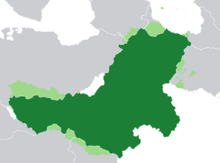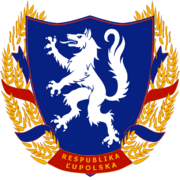Luepolan language: Difference between revisions
(→Gender) |
(→Gender) |
||
| Line 225: | Line 225: | ||
====Gender==== | ====Gender==== | ||
Luepolan features three distinct genders: [[wikipedia:masculine gender|masculine]] ('' | Luepolan features three distinct genders: [[wikipedia:masculine gender|masculine]] (''múžănski''), [[wikipedia:feminine gender|feminine]] (''ženăvski''), and [[wikipedia:neuter gender|neuter]] (''sřédovi''). The genders of words are inherited from Proto-Molvic, or from the source language if it is a loanword (frequently {{wpl|German language|Vierz}}), and as such do not fully correspond to orthographic or phonologic features. Nonetheless, certain patterns may be approximated to help new learners of the language discern the gender of a noun. These features are thus considered 'normative' for words of their given gender. | ||
* Nouns ending in -e or -o will always be neuter. | * Nouns ending in -e or -o will always be neuter. | ||
* Nouns ending in -a will usually be feminine; this is considered the standard form for feminine words. | * Nouns ending in -a will usually be feminine; this is considered the standard form for feminine words. | ||
Latest revision as of 01:44, 15 June 2023
This article is incomplete because it is pending further input from participants, or it is a work-in-progress by one author. Please comment on this article's talk page to share your input, comments and questions. Note: To contribute to this article, you may need to seek help from the author(s) of this page. |
| Luepolan | |
|---|---|
| Ľupolski Ézik | |
| Native to | Luepola |
Native speakers | 83 million (2013) |
| |
| Official status | |
Official language in | |
Recognised minority language in | |
| Regulated by | Luepolan Language Society |
| Language codes | |
| ISO 639-3 | lup |
 Areas where Luepolan is spoken by over 50% of the population Areas where Luepolan is spoken by at least 10% of the population | |
Luepolan (/luˈpoʊlən/), or the Luepolan language (Ľupolski ézik [ʎuˈpɔlski e:ˈzik]) is a South Molvic language that evolved in eastern Patyria. It is spoken by approximately 83 million speakers worldwide, the majority of whom live in Luepola, where it is the sole national language.
History
Geographic Distribution
Phonology
| Labial | Alveolar | Post- alveolar |
Palatal | Velar | Glottal | ||
|---|---|---|---|---|---|---|---|
| Nasal | m | n | ɲ | ||||
| Plosive | voiceless | p | t | c | k | ||
| voiced | b | d | ɟ | ɡ | |||
| Affricate | voiceless | t͡s | t͡ʃ | ||||
| voiced | d͡z | d͡z | |||||
| Fricative | voiceless | (f) | s | ʃ | x | ||
| voiced | v | z | ʒ | h | |||
| Tap | ɾ | ||||||
| Trill | plain | r | |||||
| fricative | r̝ | ||||||
| Approximant | plain | r | j | ||||
| lateral | l | ʎ | |||||
| Front | Back | |||
|---|---|---|---|---|
| short | long | short | long | |
| Close | i | iː | u | uː |
| Mid | e | eː | ɔ | (ɔː) |
| Open | a | aː | ||
Orthography
Grammar
Luepolan grammar is primarily fusional; adjectives, nouns, and verbs alike undergo declension and conjugation to specify their function and meaning. A small number of clitics are additionally present, such as naj and se-, which are separate from the main processes of grammatical alteration.
The primary parts of speech of Luepolan are nouns, verbs, adjectives, adverbs, numbers, prepositions, conjunctions, and interrogatives.
Word Order and Sentence Structure
Noun and Adjective declension
Like most other Molvic languages, Luepolan nouns possess an inherent gender, and decline to show case and number.
Case
Luepolan features six cases. The first two cases, the nominative and accusative, distinguish the subject of the sentence and direct objects, while the remaining four denote indirect objects (dative) as well as various prepositional objects and other syntactic relationships between the word and the phrase. Luepolan, much like Venayan and Zacotian, lost use of the Proto-Molvic vocative case present in other Molvic languages. Adjectives are also declined by these cases to match the case of the noun they modify.
| No. | Luepolan name | Case | Main usage |
|---|---|---|---|
| 1. | Benenni | nominative | Subjects |
| 2. | Anklagni | accusative | Noun adjuncts, possession, prepositions of motion, time and location |
| 3. | Coigeni | genitive | Indirect objects, prepositions of motion |
| 4. | Gebenni | dative | Direct objects, prepositions of motion and time |
| 5. | Ortovani | locative | Prepositions of location, time and topic |
| 6. | Vomeni | instrumental | Passive agents, instruments, prepositions of location |
Gender
Luepolan features three distinct genders: masculine (múžănski), feminine (ženăvski), and neuter (sřédovi). The genders of words are inherited from Proto-Molvic, or from the source language if it is a loanword (frequently Vierz), and as such do not fully correspond to orthographic or phonologic features. Nonetheless, certain patterns may be approximated to help new learners of the language discern the gender of a noun. These features are thus considered 'normative' for words of their given gender.
- Nouns ending in -e or -o will always be neuter.
- Nouns ending in -a will usually be feminine; this is considered the standard form for feminine words.
- Nouns ending in -ija will always be feminine.
- Nouns ending in a 'hard' consonant will usually be masculine.
- Nouns ending in a 'soft' consonant (ć, đ, ľ, ň, ř, ť) will often be feminine.
Luepolan additionally possesses a system by which certain nouns, usually masculine, can be altered to form words of a new gender. For example, the irregular masculine bali (physician) can be altered to form bala (female physician). This method is acknowledged by the Luepolan Language Society as a method for producing new feminine and neuter nouns, rather than as a method of altering original nouns; in the given example, bali and bala would receive separate dictionary entries.
Number
Verb Conjugation
Class
Aspect
Tense
Mood
Vocabulary
Luepolan vocabulary is notable in comparison to other Molvic languages for its conservative lexicon; a greater percentage of lemmas in Luepolan have no distinction (or minimal distinction) from their Proto-Molvic ancestor than of other Molvic languages; this is in part due to Luepola's historic role as a regional power striving to maintain its cultural integrity, as well as due to its historical home region being surrounded on all sides by those of other Molvic languages. Luepolan is also notable due to its central position among the three branches of Molvic languages; though it most directly classifies as a South Molvic language, northern dialects historically developed notable substrates from East and West Molvic languages via Aneskan and Mogrennic respectively, incorporating vocabulary as well as grammatical and phonological features from the two. The northern dialects were later merged into the southern dialects as part of Luepola's various historic linguistic reforms, impressing the influence of these languages upon the Standard Luepolan.
Loanwords
Of the foreign, non-Molvic loanwords into Luepolan, the greatest percentage of them derive from Vierz, owing to the significant and protracted cultural contact between Vierzland and Luepola, and the former's cultural influence on the latter. In particular, many Luepolan terms relating to modern sciences, warfare, and politics derive from Vierz. Examples of Luepolan loanwords from Vierz include Hautbecirk (Capital District) from Vierz Hauptbezirk, Muzika from Musik, Befél (a command, an order) from Befehl. The names of Luepola's noun cases listed above are also derived from the Vierz-language names for these cases: Benenne, Anklage, Zeugefall, Gegebene, Ortsfall, Womit-Fall.
